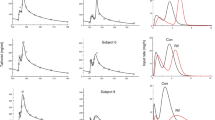Summary
To aid interpretation of the fall in the serum concentrations of rifampicin observed in the early phase of continuous treatment, the distribution of the antibiotic was assessed simultaneously in the serum, bile, and urine of patients treated for one week. Transfer constants between these compartments were calculated on the 1st and 7th day of treatment by multicompartmental kinetic analysis. — The results obtained suggest that the decrease in serum concentrations is due to enhanced biliary excretion; no significant change was observed in the amount of antibiotic excreted in the urine. The increased capacity of the liver to excrete rifampicin in bile might result from enzyme induction by the antibiotic in hepatocytes.
Similar content being viewed by others
References
Acocella, G., Pagani, V., Marchetti, M., Baroni, G.C., Nicolis, F.B.: Kinetic studies on rifampicin. I. Serum concentrations analysis in subjects treated with different oral doses over a period of two weeks. Chemotherapy16, 356 (1971).
Fürész, S., Scotti, R., Pallanza, R., Mapelli, E.: Rifampicin: a new rifamycin. III. Absorption, distribution and elimination in man. Arzneimittel-Forsch.17, 726 (1967).
Berman M.: Compartmental analysis in kinetics. In: Computers in Biomedical Research. Vol. 2, p. 173. Stacy R. W., Waxman B. D. Eds. New York: Academic Press 1965.
Cook, D.L., Lawler, C.A., Calvin, L.D., Green, D.M.: Mechanisms of bile formation. Amer. J. Physiol.17, 62 (1952).
Maggi, N., Fürész, S., Pallanza, R., Pelizza, G.: Rifampicin desacetylation in the human organism. Arzneimittel-Forsch.19, 651 (1969).
Riess, W., Schmid, K., Keberle, H., Dettli, L., Spring, G.: Pharmacokinetic studies in the field of rifamycins. Progress in Antimicrobial and Anticancer Chemotherapy, vol. 2, p. 905. University of Tokyo Press, 1970.
Jezequel, A.M., Orlandi, F., Tenconi, L.T.: Changes in the smooth endoplasmic reticulum induced by rifampicin in human and guinea pig hepatocytes. Gut12, 984 (1971).
Curci, G., Ninni, A., Fabbroncini, V.: Ricerche sul legame farmacoproteico e sul metabolismo della rifampicina. Rif. med.8, 3 (1970).
Michot, F., Bürgi, M., Büttner, J.: Rimactan (Rifampizin) und Anticoagulantien-Therapie. Schweiz. med. Wschr.100, 583 (1970).
De la Roy, Y.R., Beauchant, G., Breuil, K., Patte, F.: Diminution du taux sérique de rifampicine par le phénobarbital. Presse Méd.79, 350 (1971).
Rundle, F.F., Cass, M.H., Robson, B., Middleton, M.: Bile drainage after choledochostomy in man, with some observations on biliary fistula. Surgery37, 903 (1955).
Author information
Authors and Affiliations
Rights and permissions
About this article
Cite this article
Acocella, G., Lamarina, A., Nicolis, F.B. et al. Kinetic studies on rifampicin. Eur J Clin Pharmacol 5, 111–115 (1972). https://doi.org/10.1007/BF00561755
Received:
Issue Date:
DOI: https://doi.org/10.1007/BF00561755




